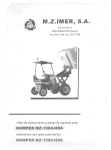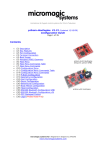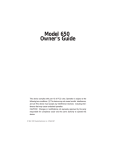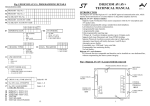Download Viper 3105V Instruction manual
Transcript
The company behind Viper® Auto Security Systems is Directed. Vista, CA 92081 www.viper.com Since its inception, Directed has had one purpose, to provide consumers with the finest vehicle security products and accessories available. The recipient of nearly 100 pat® ents and Innovations Awards in the field of advanced electronic technology. Quality Directed products are sold and serviced throughout North America and around the world. Call (800) 876-0800 for more information about our products and services. No One Dares Come Close ® © 2012 Directed. All rights reserved. Vista, CA 92081 www.directed.com G3105V 2012 09 Directed is committed to delivering world class quality products and services that excite and delight our customers. O W N E R’ S GUIDE M O D E 3105V L Congratulations Congratulations on the purchase of your state-of-the-art security system. Reading this Owner’s Guide prior to using your system will help maximize the use of your system and its many features. For more information please visit the below website: http://www.viper.com – For general and additional guide information. For any additional questions please contact your authorized Directed dealer or contact Directed at 1-800-753-0600. (U.S. only) What you get Welcome to the best generation of security. Your system contains everything you need. s s s Two 1-way remote controls (p/n 7145V) Owner’s guide Warranty card Important information Government Regulations and Safety information Read the Government Regulations and Warning! Safety First sections of this manual prior to operating this system. Your Warranty Your system comes with a warranty. Please make sure you receive the warranty registration card and proof of purchase from your dealer indicating the product was installed by an authorized Directed dealer. You can validate it online at www.prodregister.com/directed or complete and return the warranty registration card. Replacement remote controls Your system comes with two 1-way emote controls (P/N 7145V). If additional remotes are desired, please see your authorized dealer or visit us at www.directedstore.com to order. System maintenance This system needs no specific maintenance beyond remote control battery replacement. See Battery Information section for more details. Contents 1-way remote control .......................................................................................... 3 Control Center..................................................................................... 4 Remote control command table .............................................................. 5 Three- button remote configuration ......................................................... 5 Remote control functions ...................................................................................... 6 Arm ................................................................................................... 6 Disarm ............................................................................................... 6 AUX ................................................................................................... 6 Panic.................................................................................................. 6 Using your system ............................................................................................... 7 Active arming...................................................................................... 7 Passive arming .................................................................................... 7 Multi-level security arming ..................................................................... 9 Arming while driving .......................................................................... 10 Disarming ......................................................................................... 10 High Security Disarm.......................................................................... 11 Disarming without a transmitter............................................................ 11 Dome light control.............................................................................. 12 Silent mode ....................................................................................... 12 Panic mode ....................................................................................... 13 Valet mode ....................................................................................... 13 Nuisance prevention circuitry .............................................................. 14 Auxiliary outputs .............................................................................................. 15 Diagnostics ....................................................................................................... 15 Arming diagnostics ............................................................................ 16 Disarming diagnostics ........................................................................ 16 System status chirps ........................................................................... 17 Table of zones ................................................................................... 17 Interpreting zone diagnostics............................................................... 18 Vehicle recovery system (VRS) ............................................................................ 18 Arming the VRS ................................................................................. 19 Triggered sequence, VRS .................................................................... 20 Disarming the VRS ............................................................................. 21 Code hopping................................................................................................... 22 Owner recognition ............................................................................................ 22 Rapid resume logic ............................................................................................ 23 Power saver mode ............................................................................................. 23 Programming options ........................................................................................ 24 Installation options ............................................................................................ 27 Security & Convenience Expansions .................................................................... 28 Battery Information ............................................................................................ 30 Battery Replacement........................................................................... 30 Battery Disposal ................................................................................ 30 Glossary of Terms.............................................................................................. 31 Government Regulations .................................................................................... 34 1-way remote control Internal antenna Transmit LED Command Buttons Feature Description Internal Antenna Used for transmitting information Transmit LED Active when transmitting information Command buttons (4) Used to perform locking, unlocking, arming and disarmig, auxiliary channel and panic activation. © 2012 Directed. All rights reserved. 3 Control Center Control button Antenna Status LED The Control Center, typically located on the upper part of the front windshield. It consists of: s s s The In-vehicle system antenna. The Status LED, as a visual indicator of the system’s status. The Control button, for placing the system into Valet Mode* and to perform the Emergency Override* operation. * See Valet Mode and Disarming without a Transmitter in the “Using your System” section of this guide. 4 © 2012 Directed. All rights reserved. Remote control command table Feature Description Lock the doors and arm the vehicle Unlock the doors and disarm the vehicle AUX Activate Silent Mode and Auxilairy functions Panic Press together to control an Auxiliary output and Three- button remote configuration This system may be used with an optional 3-button remote, which is available for purchased through your authorized Directed dealer. The table below describes the basic 3-button functions. Button Command Lock and unlock the doors, arm and disarm the vehicle and AUX Activate Silent Mode and Auxilairy functions Panic © 2012 Directed. All rights reserved. 5 Remote control functions The remote control buttons are used to send commands to the system.The descriptions below reflect the standard configuration for this system. The buttons can be custom configured for the user’s specific needs by the installer. Arm Press and release . Doors lock and system is armed. Disarm Press and release . The doors unlock and system is disarmed. AUX Press and release AUX Silent mode and an optional auxilairy function are controlled by pressing this button. (Silent Mode works by pressing this button for less than one second before arming or disarming. An optional auxiliary function, such as trunk release, can be controlled by pressing this button for 1.5 seconds.) The auxiliary output controls __________________________. Panic Press and hold The panic feature is controlled by pressing this button for two seconds. Optional auixiliary Press and simultaneously. An optional auxiliary convenience or expansion function that you have added to your system can be activated by pressing these buttons simultaneously. The auxiliary output controls_________________________. 6 © 2012 Directed. All rights reserved. Using your system Active arming You can activate or arm the system by pressing for one second. When the system arms you will hear a short siren sound or chirp, and the parking lights flash once. If the vehicle’s power door locks have been connected to the system, the doors lock. While the system is armed the status LED flashes once per second, indicating that the system is active and protecting your vehicle. If you hear a second chirp after arming and see the status LED flashing in groups, refer to the Diagnostics section of this guide. This extra chirp is called Bypass Notifification. Passive arming The system can be programmed to arm itself automatically, this is called passive arming. If the system is programmed for passive arming, it will automatically arm 30 seconds after the ignition is turned off and the system detects that you have left the vehicle by opening and closing a door. Whenever the system is in its 30-second passivearming countdown, the status LED flashes twice as fast as it does when the system is armed. The siren chirps one time 20-seconds after the last door has been closed to indicate that the system is about to arm. At the 30-second point the parking lights flash to indicate that the system is armed. If any protected entry point (such as a door or a switch-protected trunk or hood) is open, the system will not passively arm (unless forced passive arming is programmed on. See Programming Options section of this guide.) Additionally, if a door, hood or trunk is triggered during the arming countdown, the 30-second countdown starts over. © 2012 Directed. All rights reserved. 7 When the system is armed: s Light impacts trigger the Warn Away® signal. When triggered,the siren chirps and the parking lights flash for a few seconds. 8 s Heavy impacts trip a Triggered Sequence. The sequence consists of the siren sounding continuously and the parking lights flashing for a pre-programmed period, which can range in duration from 1 to 180 seconds. s If a door is opened, the system will immediately start chirping the siren and flashing the parking lights. Three seconds later, the siren output changes to a continuous blast. This progressive response gives you time to disarm the system with your LCD remote if you inadvertently open the door while the system is armed, while still providing instant response (even if the door is immediately closed). s Turning on the ignition key will trip the same progressive response as opening a door. s The optional starter kill prevents the vehicle’s starter from cranking. © 2012 Directed. All rights reserved. Multi-level security arming Multi-Level Security Arming allows you to select which of the security system’s inputs or sensors are active, or are bypassed when the system is armed. (See the Table of Zones section of this guide) Press one time to arm the system, siren chirps one time. Pressing again activates Multi-Level Security Arming. is pressed consecutively, a different security level is Each time selected, as described in the below table: Siren chirps Zone bypassed Twice Twice followed by 1 long chirp 2 3 times 3 times followed by 1 long chirp 4 4 times 4 times followed by 1 long chirp 2&4 5 times 5 times followed by 1 long chirp all zones except 5 Press Each press of the button ascends to the next security level. Multi-Level Security Arming applies to a single arming cycle. Once the system is disarmed and then re-armed, all the zones will be active again. © 2012 Directed. All rights reserved. 9 Arming while driving Your system can be armed while driving the vehicle. Press on your transmitter for two seconds while the vehicle is running or while the ignition is on. The siren chirps once, and then once more indicating that the ignition is on. The security system does not respond to any input except the door triggers and the Failsafe® Starter Kill (if installed) will not activate. The security system disarms automatically when the ignition is turned off. The siren chirps twice and the LED stops flashing. Note: If programmed for the optional Vehicle Recovery System (VRS) feature, arming with the transmitter activates the VRS feature. (See VRS section of this guide.) Disarming To disarm the system, press . You will hear two chirps, and the parking lights will flash twice. If the power locks are connected to the system, the doors will unlock. If the siren chirps either four or five times when disarming, refer to the Diagnostics section of this guide. This is called Tamper Alert. 10 © 2012 Directed. All rights reserved. High Security Disarm High Security Disarm makes it possible to silence and reset the system when it is triggering, without disarming. If the system is triggered, and the siren sounds for longer than six seconds, pressing will stop the trigger and return the system to an armed state. The system does not disarm, but rather reset. This prevents you from disabling the system should you want to disarm without visually checking the vehicle. Pressing again after resetting the system, will disarm the system. Pressing during the first six seconds of the triggered sequence disarms the system immediately. The six second timer is provided for your convenience, in case you accidentally trigger the system. Disarming without a transmitter This feature allows you to disarm the security system without the remote transmitter should it be lost, damaged, or disabled. In order to disarm the system without a remote transmitter, you must have the vehicle’s ignition key and know where the Valet button is located. Be sure to check with the installer for the location and the number of presses of the Valet button required to disarm the system. To disarm the security system: 1. 2. Turn the ignition to the ON position. Press and release the Valet button the preset number of times (one, the factory setting, to five times) within 15 seconds. After five seconds the system disarms. If the system does not disarm, you may have waited too long. Turn the ignition off and on and try again. © 2012 Directed. All rights reserved. 11 Location of Valet Button_________________________________ Number of Pulses______________________________________ The unit responds to one to five pulses of the Valet button when disarming. Check with your installer to discuss how you want the system configured. Note: As a precaution, if programmed for passive arming the system should be placed into Valet Mode until a remote is available. Dome light control Security only The dome light activates for 30 - seconds after the system is disarmed. Ignition controlled The dome light activates for 30 - seconds after the ignition is turned Off. (may be programed to On or Off, by the dealer installer) Silent mode To temporarily turn off the arm or disarm chirps, use Silent Mode. Press AUX for less than one second before arming or disarming, and the confirmation chirp(s) will be eliminated for that one operation only. If you want the arm/disarm chirps turned off permanently, your dealer can do this for you. The Warn Away response to lighter impacts is bypassed if the system is armed using Silent Mode. This ensures that no chirps will be emitted by the siren in an area you want chirp-free. The system is still capable of triggering, but the Warn Away response is bypassed. 12 © 2012 Directed. All rights reserved. Panic mode If you are threatened in or near your vehicle, you can attract attention by triggering the system with your remote. Press for approximately two seconds, to enter Panic Mode. The siren sounds and the parking lights flash for the programmed siren duration. To stop Panic Mode at any time, press the . Valet mode You can prevent your security system from automatically arming and triggering by using Valet Mode. This is very useful when washing the vehicle or having it serviced. In Valet Mode, the security system will not arm, even with the remote transmitter, but all convenience functions (door locks, trunk release, etc.) will continue to work normally. To enter or exit Valet Mode: 1. Turn the ignition on. 2. Turn the ignition off. 3. Press and release the Valet switch within 10 seconds. The status LED lights solidly if you are entering Valet Mode, and goes out if you are exiting Valet Mode. To enter or exit Valet Mode with the remote: Open any vehicle door, and then quickly press the following buttons in the sequence indicated. 4. Press . 5. Press AUX and then press again. The in - vehicle status LED lights solidly if you are entering Valet Mode, and goes out if you are exiting Valet Mode. © 2012 Directed. All rights reserved. 13 Nuisance prevention circuitry Your system has Directed’s Nuisance Prevention Circuitry (NPC). It prevents annoying repetitive trigger sequences due to faulty door pin switches or environmental conditions such as thunder, jackhammers, or airport noise. For example, if the alarm triggers three times within a 60- minute period and each time the same sensor or switch triggers the alarm, NPC will interpret those triggers as false alarms. After the third trigger, NPC ignores, or bypasses that sensor or switch (along with any other sensors or switches sharing the same zone) for 60- minutes. If the bypassed sensor tries to trigger the system while it is being bypassed, the 60 - minute bypass period starts over. This ensures that a sensor that continually triggers will remain bypassed. Doors are covered by NPC differently - if the alarm is triggered by an open door for three full cycles, the doors are bypassed until the trigger ceases. NPC is On/Off programmable, except doors are always covered whether on or off. See your dealer and the Programming section of this guide for more information. Arming and disarming the system does not reset this function. In order to reset a bypassed zone, the same zone must not trigger for 60 minutes, or when ignition is turned on. If testing your system, it is important to remember that the NPC programming can cause zones to be bypassed and appear to stop working. If five chirps are heard when disarming, NPC has been engaged. If you wish to clear the NPC memory, turn the ignition key on. 14 © 2012 Directed. All rights reserved. Auxiliary outputs This system also supplies outputs that can control convenience options such as remote control trunk release and window automation. Consult your dealer for available options for your system. Channel 2 Trunk release: When connected, pressing AUX for 1.5 seconds will remotely release the vehicle trunk lid. Channel 3 auxiliary output: When connected, pressing and will immediately activate this output to control an additional convenience option. Diagnostics The microprocessor at the heart of your security system is constantly monitoring all of the switches and sensors that are connected to it. It detects any faulty switches and sensors and prevents them from disabling the entire system. The microprocessor will also record and report any triggers that occurred during your absence. Refer to the System Status Chirps and Table of Zones charts for diagnostic information. © 2012 Directed. All rights reserved. 15 Arming diagnostics If the system is armed while an input is active - door open, sensor triggering - the unit chirps once when arming and then one more time a few seconds later. This is called Bypass Notification. Bypass Notification does not occur when using Silent Mode or if chirps have been programmed OFF. The security system continually ignores the zone that was active until the input stops. Three seconds after the input stops, the system monitors that input normally. For example, if your vehicle has interior light exit delay and you arm it before the interior light goes out, you may hear Bypass Notification chirps. Once the light shuts off, the doors are monitored normally. Disarming diagnostics Extra disarm chirps are the Tamper Alert. If four chirps are heard when disarming, the system was triggered in your absence. If five chirps are heard, a zone was triggered so many times that Nuisance Prevention® Circuitry has bypassed that zone (see NPC section of this guide). The in-vehicle status LED indicates which zone was involved. (See Table of Zones section of this guide.) The system retains this information in its memory, and continues to chirp four or five times each time it is disarmed, until the next time the ignition key is turned on. 16 © 2012 Directed. All rights reserved. System status chirps The siren chirps when arming/disarming the system. The pattern of chirps audibly report the system’s status as described below. Action Chirps Description Arm 1 System armed Arm 3-second delay, 1 System armed with Bypass Notification Disarm 2 System disarmed Disarm 4 System disarmed with Tamper Alert Disarm 5 System disarmed NPC active Table of zones The zone number is the number of LED flashes used by the system to identify that input. The standard input assignments are listed below, along with spaces to write in any optional sensors or switches you have had installed. Warn away responses are not reported in the table of zones. Zone/LED Flashes Description 1 Instant trigger: Often used for trunk pinswitch 2 Shock sensor input: a light impact activates Warn away and a heavier impact activates full alarm. 3 Door switch trigger 4 Optional sensor inputs for Warn away and full alarm notification. 5 Ignition trigger © 2012 Directed. All rights reserved. Dealer installed options 17 Interpreting zone diagnostics Warn Away responses are not reported by arming or disarming diagnostics. If you receive a Bypass notification when arming or a Tamper Alert notification when disarming, look at the in-vehicle status LED. Active or triggered zones will be indicated by a pattern of blinks by this LED. For Example: If Zone 3 was active or triggered, the in-vehicle LED will blink three times with a two-second pause. Then it will blink three times again, and repeat until the ignition is turned on. Your system stores the last six triggered zones in memory. If your system has been triggered but the LED has been reset by turning on the ignition, your dealer can still recall the last six zones that were triggered. Contact your dealer for details. Vehicle recovery system (VRS) The optional VRS® feature is designed to ensure that any unauthorized user of your vehicle (even if using your keys and remote control) will not be able to permanently separate you from your vehicle. The VRS cannot prevent a carjacking attempt; however, it does ensure that if your vehicle is taken by an unauthorized user, it will be disabled (after several progressive warnings) as safely as possible. Should a carjacking occur, the VRS allows you to concern yourself with your personal safety without worrying about your property. Directed has engineered this vehicle security system, the Failsafe® Starter Kill, and the VRS feature to provide the best combination of personal safety and property protection available. When properly 18 © 2012 Directed. All rights reserved. installed, the system can never inadvertently stop your vehicle in traffic or on railroad tracks while the vehicle is in operation. It is unlike other systems that shut down your engine while it is running. This system is designed to perform starter interrupt, or starter kill. The Failsafe Starter Kill cannot shut down an already-running engine – it can only prevent an engine from starting in the first place. Important! Any installation that allows this product to shut down a vehicle’s engine when it is running is contrary to the product’s design and intended usage, and Directed hereby expressly disclaims any liability resulting therefrom. Arming the VRS To arm the VRS, turn the ignition to the ON position and press the arm button on the remote transmitter for one second. The parking lights will flash and the siren will chirp once. This can be done before driving or while driving the vehicle. Once the system is armed, it will initiate its triggered sequence (see following Triggered Sequence section) if any door is opened and closed. If you are forced from the vehicle, the system will trigger as the door is opened and closed. This is how the system works to combat intersection carjacking. To protect against parking lot carjacking, arm the VRS before leaving the vehicle. The system will now trigger automatically the next time you or anyone drives the vehicle. This helps to protect the vehicle if someone takes your keys and remote transmitter by force in a parking lot. If the VRS system is armed while operating the vehicle and not disarmed prior to leaving the vehicle, it is still armed and will trigger the next time the vehicle is driven. © 2012 Directed. All rights reserved. 19 Triggered sequence, VRS Fifteen seconds after the last door has closed, the in-vehicle LED will begin flashing. This delay is intended to allow you time to distance yourself from your vehicle in the event of a carjacking. Forty-five seconds later, the siren begins chirping and the parking lights begin flashing. This time could be used to notify authorities that your vehicle has been hijacked, and tell them what the VRS will do next. Fifteen seconds after the siren chirps begin, the siren’s output will change to a continuous blast. From this point on, when the ignition key is turned off, the VRS will immediately turn on the starter kill. This will prevent the vehicle from being restarted, thus immobilizing it at that spot. Three minutes after the constant siren output begins, the flashing parking lights and the siren will stop. The starter kill will remain active until the system is disarmed. If the door is opened or the ignition is turned off and on in an attempt to restart the car, the siren and light flashing will begin again. 20 © 2012 Directed. All rights reserved. Disarming the VRS Take the time to familiarize yourself with the VRS triggering sequence and the disarm procedure. It is important to recognize and identify the VRS trigger sequence and know how to disarm it in case of accidental activation. Once the VRS is armed, it does not disarm automatically. You must disarm it the next time you operate the vehicle. You must disarm it with one of the following procedures: If the system has not entered the triggered sequence (siren has not started chirping): 1. Turn the ignition on. 2. Press on the remote control for 1 second. The lights flash and the siren chips. If the system has entered the triggered sequence (siren has begun chirping), pressing the disarm button of the transmitter will not disarm VRS. To disarm the VRS during a VRS trigger sequence: 3. Turn the ignition on. 4. Press the Valet button the pre-programmed number of times to disarm the VRS system. If the VRS has begun its chirping sequence, the ignition must be turned off, then On, to disarm. If you are driving the vehicle, pull over to a safe place and follow the triggered sequence disarm procedure. Note: The unit responds to 1 to 5 valet button presses to disarm the VRS (factory setting is 1 press). Check with your installer to determine the setting you want. © 2012 Directed. All rights reserved. 21 Code hopping The receiver and transmitters each use mathematical formulas called algorithms to change their codes each time the transmitter is used. This technology has been developed to increase the security of the unit. The control unit knows what the next codes should be. This helps to keep the transmitter “in sync” with the control unit even if you use the remote control out of range of the vehicle. However, if the transmitter has been pressed many times out of range of the vehicle, or if the battery has been removed, it may get out of sync with the control unit and fail to operate the system. To re-sync the remote control simply press several times within range of the vehicle. The alarm will automatically re-sync and respond to the transmitters normally. Owner recognition Owner Recognition is a feature available exclusively from Directed. Using the Directed Bitwriter®, a hand-held programming tool, your dealer can program many of the system settings. The programmer makes it possible to program different settings for each transmitter that is used with the system. Then, whenever a specific transmitter is used, the system will recall the settings assigned to that transmitter. Owner Recognition lets up to four users of the system have different settings that meet their specific needs. It is almost like having four separate alarms in your vehicle, one for each user. Owner Recognition cannot be programmed without a Directed Bitwriter® and the necessary software. Check with your dealer for more information. 22 © 2012 Directed. All rights reserved. Rapid resume logic This Directed system will store its current state to non-volatile memory. If power is lost and then reconnected, the system will recall the stored state from memory. This means if the unit is in Valet Mode and the battery is disconnected for any reason, such as servicing the car, when the battery is reconnected the unit will still be in Valet Mode. This applies to all states of the system including arm, disarm, VRS, and Valet Mode. Power saver mode Your system will automatically enter Power Saver Mode while armed or in Valet® Mode, after a period of time in which no operation has been performed. This lowers the current draw to the vehicle’s battery. Power Saver Mode takes over under the following conditions: s Power Saver when the system is armed: After the system has been armed for 24 hours, the in-vehicle LED will flash at half its normal rate, decreasing the system’s current draw. s Power Saver in Valet Mode: When the system enters Valet Mode the in-vehicle LED illuminates steadily. If the vehicle is not used (ignition is not turned on) for a period of one hour while the system is in Valet Mode, the LED will shut off. If the system remains in Valet Mode, the LED will come back on the next time the ignition is turned on and then back off. © 2012 Directed. All rights reserved. 23 Programming options Programming options control what your system does during normal operation, and require few or no additional parts. However, some may require additional installation labor. The following is a list of the program settings, with the factory settings in Bold: s Active arming (only with the remote) or passive arming (automatic arming 30- seconds after the last door has been closed). Arming/disarming s The ignition controlled door lock feature On or off: With this feature on, the doors will lock three seconds after the ignition is turned on, and the doors are closed, and unlock when the ignition is turned off. The system will not lock the doors when the ignition is turned on with any door open. Ignition lock and unlock are independent features and can be programmed separately, when using the Bitwriter. s Passive door locking (with passive arming) or active door locking (only when arming with the remote). Passive locking allows the vehicle’s doors to lock when the security system passively arms (after the 30 second countdown). This feature only works if passive arming has been programmed. When programmed for passive arming and active lock, if the system is disarmed without a door being opened, the system will re-lock the doors when it passively rearms. 24 confirmation siren chirps On s or off. © 2012 Directed. All rights reserved. s Panic mode enabled/disabled with the ignition on: Some states have laws against siren capability in a moving vehicle. s Forced passive arming On or off: If your system is programmed for passive arming and the forced passive arming feature has been programmed on, the system will passively arm after one hour, even if a protected entry has been left open. This feature is useful if a door has been left ajar when leaving the vehicle. Forced passive arming ensures that the security system will be armed in every situation. When the system passively arms after one hour, the entry point that has been left open, and anything connected to the same zone, is bypassed and cannot trigger the system. However, the remaining inputs to the system are fully operational. s Automatic Engine Disable (AED) on or Off: The purpose of this feature is to protect the vehicle from being stolen at all times, regardless of whether or not the alarm is armed. If AED is programmed on, the starter of the vehicle will be disabled 30 seconds after the ignition is turned off. Once the key is turned off, the in-vehicle LED will flash slowly (one-half its normal armed rate) to indicate the AED arming cycle. Thirty seconds later, the starter of the vehicle will be disabled. To start the car, it will be necessary to disarm the system with the remote. It is also possible to disarm the AED feature by turning the ignition key to the RUN position and pressing the Valet button the programmed number of times. AED is disabled when the system is in Valet Mode. This feature only functions if the Failsafe® Starter Kill relay has been installed. © 2012 Directed. All rights reserved. 25 s Full trigger response 30 or 60 seconds: This determines how long the full triggered sequence lasts. Some states have laws regulating how long a security system can sound before it is considered a nuisance. If your installer is programming the security system with the Directed Bitwriter, the full triggered response can be programmed for any duration ranging from 1 to 180 seconds. s Nuisance Prevention Circuitry On or off: Please refer to the NPC section of this manual for a complete explanation of how NPC operates. If NPC is programmed off, the security system will respond to inputs from any sensor indefinitely. Because many states have laws regulating security systems, programming NPC® off may cause your system to violate state laws. s Progressive door trigger On or off: When the system is armed and a door is opened, the system responds with ten chirps prior to beginning the full triggered sequence. If an instant trigger is desired, the progressive door trigger can be programmed off. s Valet pulse count: The number of Valet button preses required to disarm the security system. AED or the VRS system can be programmed from 1 to 5 presses. s Comfort Closure: Windows will close upon locking the vehicle. 26 © 2012 Directed. All rights reserved. Installation options The system has many options that may require extra parts and labor. Some of the possibilities are listed here. s Progressive unlocking: In most cars with electric power door locks, the system can be configured so that when the system is disarmed, only the driver’s door unlocks. A second press of the button unlocks the other doors. s Vehicle Recovery System, (VRS): It is an anti-carjacking device designed to help in the safe recovery of your vehicle in case of a carjacking. Please refer to the Vehicle Recovery System section of this guide for a complete explanation of how the Vehicle Recovery System operates. © 2012 Directed. All rights reserved. 27 Security & Convenience Expansions Listed are some of the many expansion options available. Please contact your dealer to find out about all the convenience options available to you. Audio Sensor: Metal on glass, cracking glass, and breaking glass each produce distinctive acoustic signatures. The 506T audio sensor uses a microphone to pick up sounds, and then using proprietary acoustic software, analyzes the sounds to determine if the glass was struck. Backup Battery: The 520T keeps the system armed, triggers the alarm and keeps the starter kill active if main battery power is disconnected. Field Disturbance Sensor: An invisible dome of coverage is established by installing the 508D “radar” sensor. Your security system can then react to any intrusions into this field with the triggered sequence. Headlight and Parking Light Automation: The 545T Nite-Lite® will automatically turn on your parking and headlights when it gets dark. In addition, the 545T will turn your headlights on whenever the windshield wipers are used. A transmitter function can also be used to turn on your parking and headlights for a programmed time. Power Trunk Release: The channel two output of the system can operate a factory power release for the vehicle’s trunk or hatch. (An additional relay may be required.) If the factory release is not power activated, then Directed’s 522T trunk release solenoid can often be added. 28 © 2012 Directed. All rights reserved. Power Window Control: Automatic power window control is provided with the 529T and 530T systems. Tilt Sensor: The 507M tilt sensor can be added to your system to protect your car when its parked. An alarm is triggered if the vehicle is lifted, to protect expensive rims. Remote Start System: For the ultimate in convenience, A Directed remote start system can start your vehicle, monitor engine functions, and power your climate control system with a push of a button. Over-rev protection, open-hood lockout, brake pedal shutoff, and automatic timer shutoff are all included. (only for automatic transmission, fuelinjected vehicles.) Ultrasonic Sensor: Provides a field of protection inside your car, the 509U Ultrasonic sensor, protects your belongings. © 2012 Directed. All rights reserved. 29 Battery Information The remote controls are powered by a pair of 3V (CR-2016) batteries that can be purchased at most retailers. When the battery begins to weaken, the operating range will be reduced. Battery Replacement Side View Slot 1. Using a small flat-headed screwdriver, insert into slot located on the side of the remote control and carefully pry open the unit. 2. Turn unit over and carefully remove the rear housing. Remove the batteries from holder and replace with a new one. Note Verify that the battery polarity is correct when replacing. 3. Reassemble all parts and snap together. Battery Disposal Directed cares about the environment. If you need to dispose of the battery, please do so in accordance with your municipal requirements for battery disposal or return to Directed at: One Viper way, Vista, CA 92081 (Shipping and/or handling costs are the sole responsibility of the owner/sender and will not be covered by Directed ). 30 © 2012 Directed. All rights reserved. Glossary of Terms Document Terminology ASK Amplitude Shift Keying—a method of transmitting data. 1-way Remote Control A hand-held remote control, also called transmitter that operates the various functions of your system but does not provide message display.. Control Button (Valet Switch) A small push button located on your system’s control center. It is used to override (disarm) the system when a remote is not available or to enter/exit valet mode Control Module (unit) The “brain” of your system. Usually hidden under the dash area of the vehicle. It houses the microprocessor which monitors your vehicle and controls all of the system’s functions. FailSafe Starter Kill A switch controlled by the security system which once activated prevents the vehicle’s starter from cranking, when the system is armed. The vehicle is never prevented from cranking when the system is disarmed, in Valet mode - or if the starter interrupt switch fails. Installation may require additional labor. Input A physical connection to the system. Input may be provided by a sensor, a pinswitch or through an existing system in the vehicle, such as ignition or courtesy lights. Siren Noise generating device usually installed in the engine compartment of the vehicle. It generates the “chirps” and the six tones you hear when the alarm is triggered. Status LED A light used to indicate the status of your system, located on your system’s Control Center. Trigger or Triggered Sequence When the alarm “goes off” or “trips”, the system triggers a sequence of siren sounding and parking lights flashing for a programmed duration. © 2012 Directed. All rights reserved. 31 Document Terminology 32 Warn Away® Lighter impacts to the vehicle generate a Warning Zone response, several seconds of siren chirps and parking light flashes. Zone Input that the alarm recognizes as unique. Each input is connected to a particular zone. Two or more inputs may share the same zone. © 2012 Directed. All rights reserved. Patent Information This product is covered by one or more of the following United States patents: Vehicle Security Patents 5,467,070; 5,532,670; 5,534,845; 5,563,576; 5,646,591; 5,650,774; 5,673,017; 5,712,638; 5,872,519; 5,914,667; 5,952,933; 5,945,936; 5,990,786; 6,028,505; 6,452,484 Remote Start 5,349,931; 5,872,519; 5,914,667; 5,952,933; 5,945,936; 5,990,786; 6,028,372; 6,467,448; 6,561,151; 7,191,053; 7,483,783 Other patents pending © 2012 Directed. All rights reserved. 33 Government Regulations This device complies with Part 15 of FCC rules. Operation is subject to the following two conditions: (1) This device may not cause harmful interference, and (2) This device must accept any interference received, including interference that may cause undesirable operation. This equipment has been tested and found to comply with the limits for a class B digital device, pursuant to Part 15 of the FCC Rules. These limits are designed to provide reasonable protection against harmful interference in a residential installation. This equipment generates and can radiate radio frequency energy and, if not installed and used in accordance with the instruction manual, may cause harmful interference to radio communications. However, there is no guarantee that interference will not occur in a particular installation. If this equipment does cause harmful interference to radio or television, which can be determined by turning the equipment OFF and ON, the user is encouraged to try to correct the interference by one or more of the following measures: s2EORIENTORRELOCATETHERECEIVINGANTENNA s)NCREASETHESEPARATIONBETWEENTHEEQUIPMENTANDRECEIVER s#ONNECTTHEEQUIPMENTINTOANOUTLETONACIRCUITDIFFERENTFROMTHATTOWHICH the receiver is connected. s#ONSULTTHEDEALERORANEXPERIENCEDRADIO46TECHNICIANFORHELP Remote Controls To satisfy FCC RF exposure compliance requirements, this device should be used in hand-held, hand operated configurations only. The device and its antenna must maintain a separation distance of 20 cm or more from the person’s body, except for the hand and wrists, to satisfy RF exposure compliance. This device is designed to be used in a person’s hands and its operating configurations do not support normal transmissions while it is carried in pockets or holsters next to a person’s body. 34 © 2012 Directed. All rights reserved. Receiver antenna To satisfy FCC RF exposure compliance requirements, the device and its antenna must maintain a separation distance of 20 cm or more from the person’s body, except for the hand and wrists, to satisfy RF exposure compliance. This device complies with the Industry Canada Radio Standards Specification RSS 210. Its use is authorized only on a no-interference, no-protection basis; in other words, this device must not be used if it is determined that it causes harmful interference to services authorized by IC. In addition, the user of this device must accept any radio interference that may be received, even if this interference could affect the operation of the device. WARNING! Changes or modifications not expressly approved by the party responsible for compliance could void the user’s authority to operate this device. © 2012 Directed. All rights reserved. 35 Limited lifetime consumer warranty Directed Electronics. (“Directed”) promises to the original purchaser to repair or replace (at Directed’s election) with a comparable reconditioned model any Directed unit (hereafter the “unit”), excluding without limitation the siren, the remote transmitters, the associated sensors and accessories, which proves to be defective in workmanship or material under reasonable use during the lifetime of the vehicle provided the following conditions are met: the unit was purchased from an authorized Directed dealer, the unit was professionally installed and serviced by an authorized Directed dealer; the unit will be profession¬ally reinstalled in the vehicle in which it was originally installed by an authorized Directed dealer; and the unit is returned to Directed, shipping prepaid with a legible copy of the bill of sale or other dated proof of purchase bearing the following information: consumer’s name, telephone number and address; the authorized dealers name, telephone number and address; complete product description, including accessories; the year, make and model of the vehicle; vehicle license number and vehicle identification number. All components other than the unit, including without limitation the siren, the remote transmitters and the associated sensors and accessories, carry a one-year warranty from the date of purchase of the same. ALL PRODUCTS RECEIVED BY DIRECTED FOR WARRANTY REPAIR WITHOUT PROOF OF PURCHASE FROM AN AUTHORIZED DEALER WILL BE DENIED. This warranty is non-transferable and is automatically void if: the unit’s date code or serial number is defaced, missing or altered; the unit has been modified or used in a manner contrary to its intended purpose; the unit has been damaged by accident, unreasonable use, neglect, improper service, installation or other causes not arising out of defects in materials or construction. The warranty does not cover damage to the unit caused by installation or removal of the unit. Directed, in its sole discretion, will determine what constitutes excessive damage and may refuse the return of any unit with excessive damage. TO THE MAXIMUM EXTENT ALLOWED BY LAW, ALL WARRANTIES, INCLUDING BUT NOT LIMITED TO EXPRESS WARRANTY, IMPLIED WARRANTY, WARRANTY OF MERCHANTABILITY, FITNESS FOR PARTICULAR PURPOSE AND WARRANTY OF NON-INFRINGEMENT OF INTELLECTUAL PROPERTY, ARE EXPRESSLY EXCLUDED; AND DIRECTED NEITHER ASSUMES NOR AUTHORIZES ANY PERSON OR ENTITY TO ASSUME FOR IT ANY DUTY, OBLIGATION OR LIABILITY IN CONNECTION WITH ITS PRODUCTS. DIRECTED DISCLAIMS AND HAS ABSOLUTELY NO LIABILITY FOR ANY AND ALL ACTS OF THIRD PARTIES INCLUDING ITS AUTHORIZED DEALERS OR INSTALLERS. DIRECTED SECURITY SYSTEMS, INCLUDING THIS UNIT, ARE DETERRENTS AGAINST POSSIBLE THEFT. DIRECTED IS NOT OFFERING A GUARANTEE OR INSURANCE AGAINST VANDALISM, DAMAGE OR THEFT OF THE AUTOMOBILE, ITS PARTS OR CONTENTS; AND HEREBY EXPRESSLY DISCLAIMS ANY LIABILITY WHATSOEVER, INCLUDING WITHOUT LIMITATION, LIABILITY FOR THEFT, DAMAGE AND/OR VANDALISM. THIS WARRANTY DOES NOT COVER LABOR COSTS FOR MAINTENANCE, REMOVAL OR REINSTALLATION OF THE UNIT OR ANY CONSEQUENTIAL DAMAGES OF ANY KIND. IN THE EVENT OF A CLAIM 36 © 2012 Directed. All rights reserved. OR A DISPUTE INVOLVING DIRECTED OR ITS SUBSIDIARY, THE VENUE SHALL BE SAN DIEGO COUNTY IN THE STATE OF CALIFORNIA. CALIFORNIA STATE LAWS AND APPLICABLE FEDERAL LAWS SHALL APPLY AND GOVERN THE DISPUTE. THE MAXIMUM RECOVERY UNDER ANY CLAIM AGAINST DIRECTED SHALL BE STRICTLY LIMITED TO THE AUTHORIZED DIRECTED DEALER’S PURCHASE PRICE OF THE UNIT. DIRECTED SHALL NOT BE RESPONSIBLE FOR ANY DAMAGES WHATSOEVER,INCLUDING BUT NOT LIMITED TO, ANY CONSEQUENTIAL DAMAGES, INCIDENTAL DAMAGES, DAMAGE TO VEHICLE, DAMAGES FOR THE LOSS OF TIME, LOSS OF EARNINGS, COMMERCIAL LOSS, LOSS OF ECONOMIC OPPORTUNITY AND THE LIKE. NOTWITHSTANDING THE ABOVE, THE MANUFACTURER DOES OFFER A LIMITED WARRANTY TO REPLACE OR REPAIR THE CONTROL MODULE SUBJECT TO THE CONDITIONS AS DESCRIBED HEREIN. THIS WARRANTY IS VOID IF THE UNIT HAS NOT BEEN PURCHASED FROM DIRECTED, OR AN AUTHORIZED DIRECTED DEALER, OR IF THE UNIT HAS BEEN DAMAGED BY ACCIDENT, UNREASONABLE USE, NEGLIGENCE, ACTS OF GOD, NEGLECT, IMPROPER SERVICE, OR OTHER CAUSES NOT ARISING OUT OF DEFECT IN MATERIALS OR CONSTRUCTION. Some states do not allow limitations on how long an implied warranty will last or the exclusion or limitation of incidental or consequential damages. This warranty gives you specific legal rights and you may also have other rights that vary from State to State. This warranty is only valid for sale of product(s) within the United States of America and in Canada. Product(s) sold outside of the United States of America or Canada are sold “AS-IS” and shall have NO WARRANTY, express or implied. For further details relating to warranty information of Directed products, please visit the support section of Directed’s website at: www.directed.com. This product may be covered by a Guaranteed Protection Plan (“GPP”). See your authorized Directed dealer for details of the plan or call Directed Customer Service at 1-800-876-0800. 920-10011-01-2011-06 © 2012 Directed. All rights reserved. 37 38 © 2012 Directed. All rights reserved.




















































